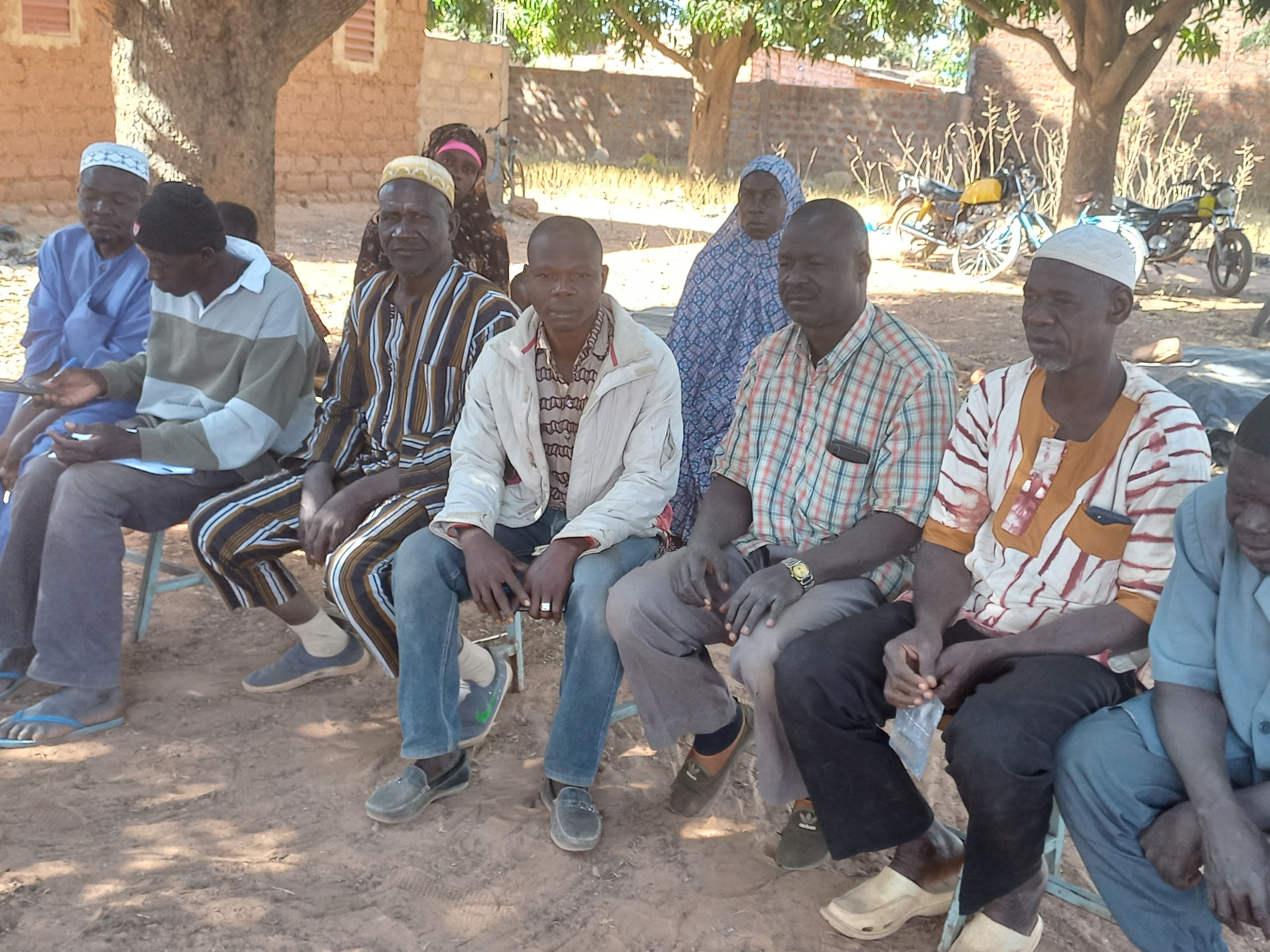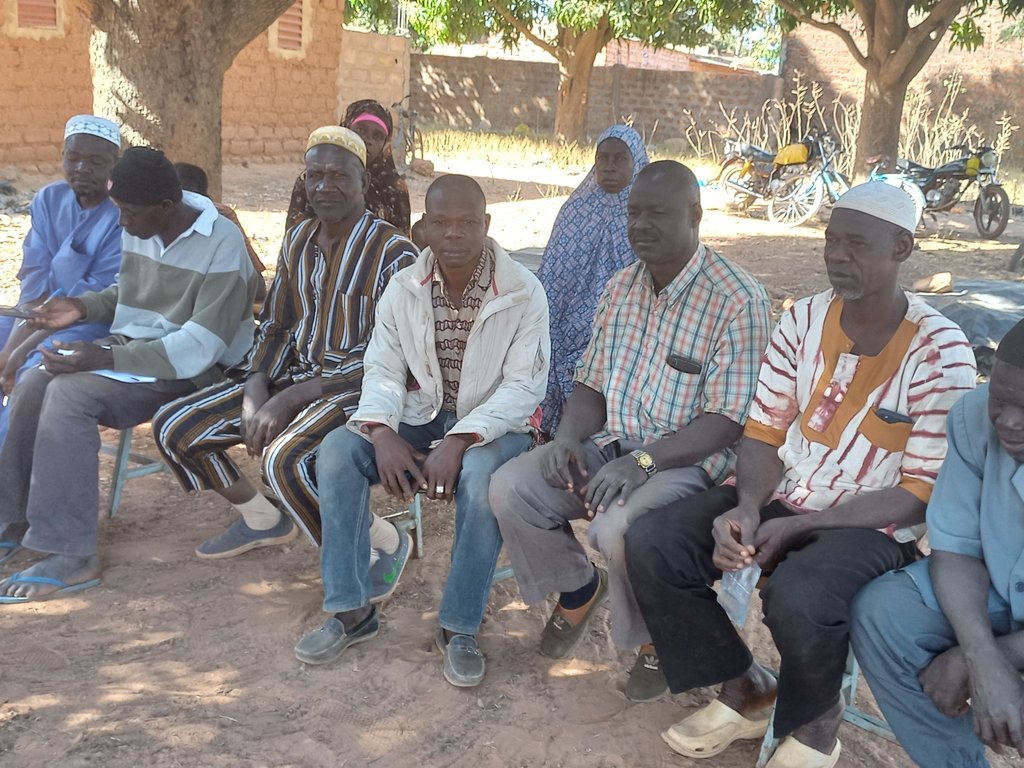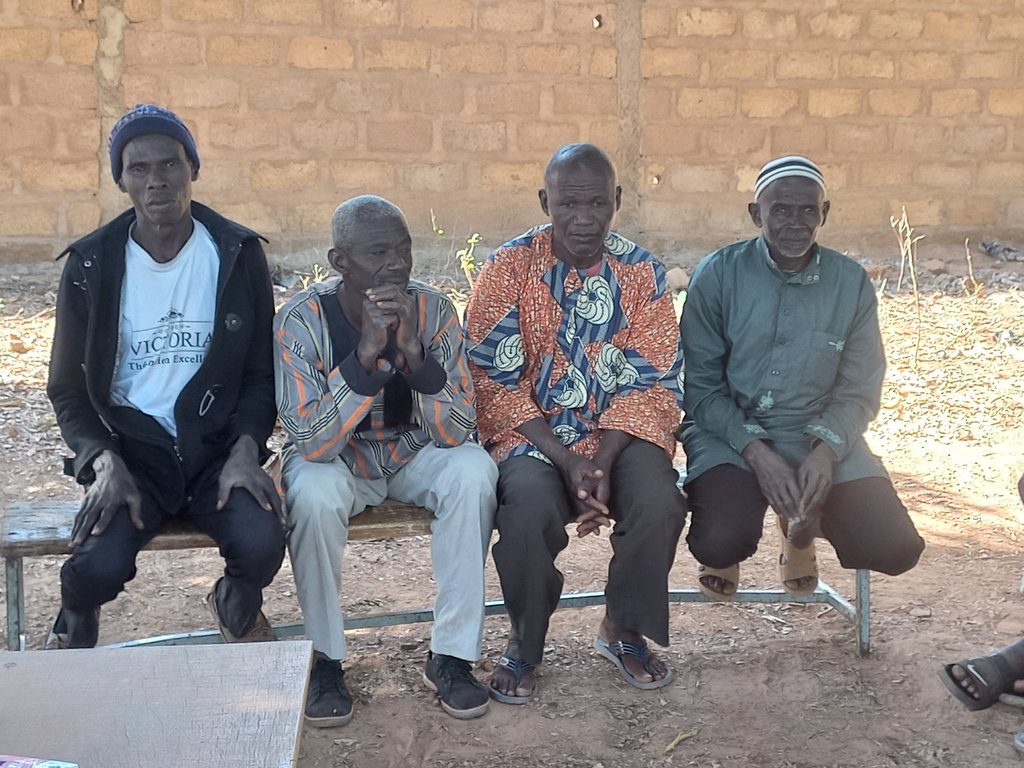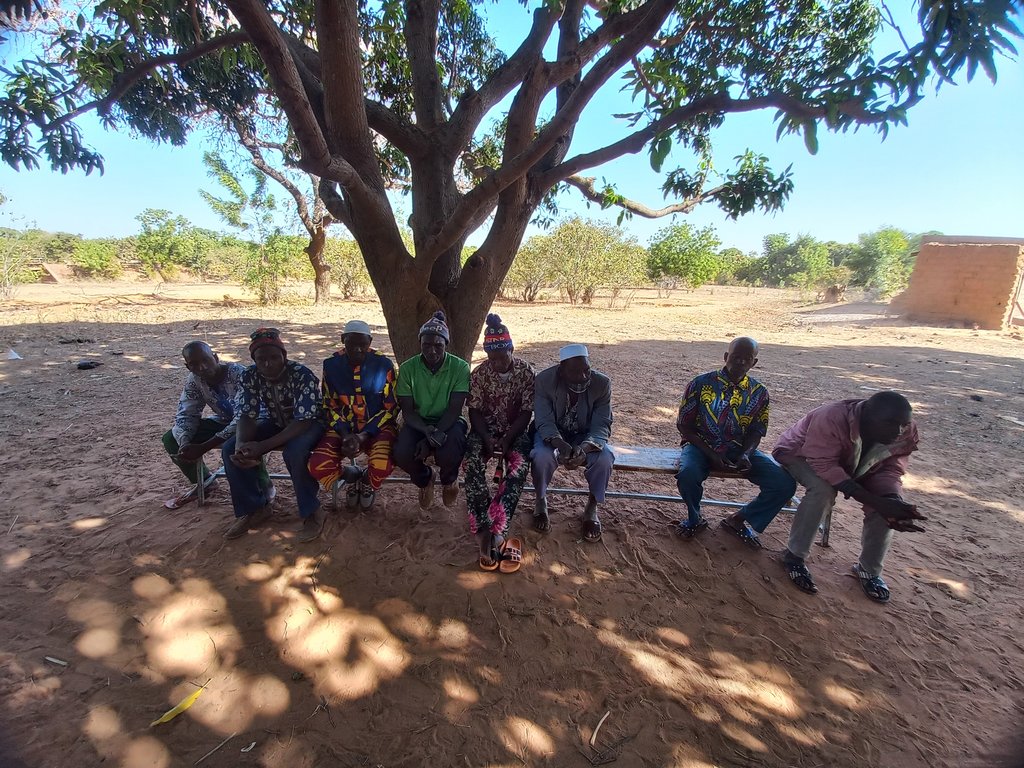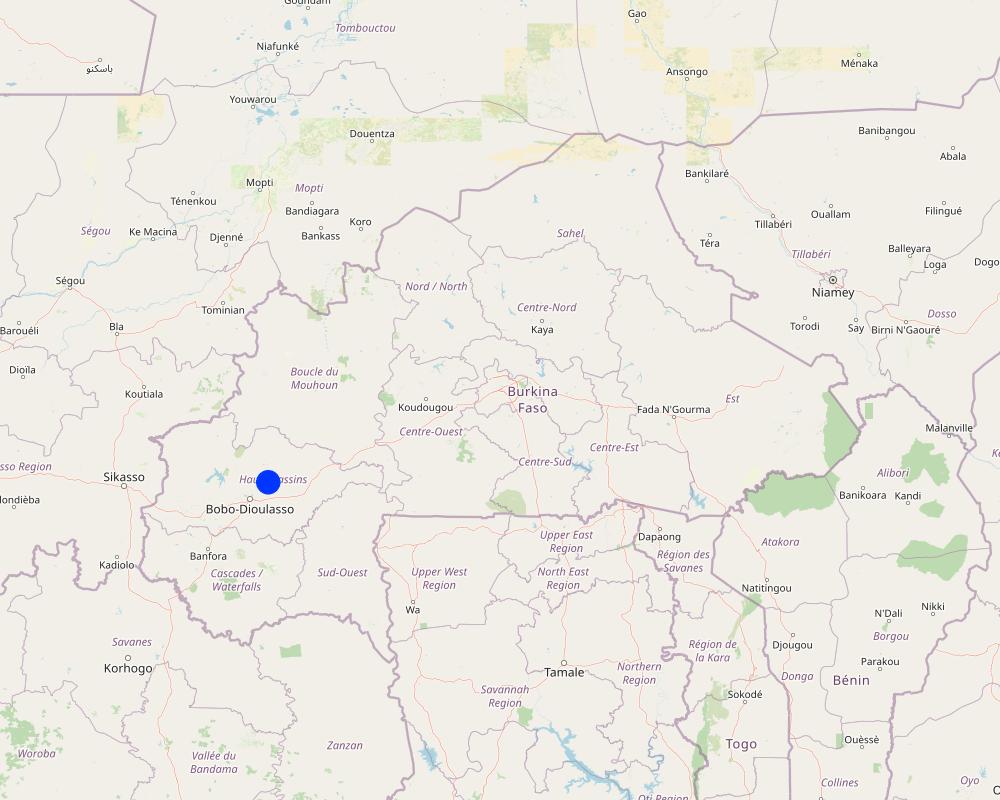Action Research on Property Right-Related Conflicts in Sala village [Burkina Faso]
- Creation:
- Update:
- Compiler: Moussa ABOU
- Editors: Brice Sosthène BAYALA, Siagbé Golli, Joachain PALE, Tabitha Nekesa, Ahmadou Gaye
- Reviewers: Sally Bunning, Rima Mekdaschi Studer, William Critchley
Doukolo Ka Ben Ka Kouma
approaches_6734 - Burkina Faso
View sections
Expand all Collapse all1. General information
1.2 Contact details of resource persons and institutions involved in the assessment and documentation of the Approach
Key resource person(s)
land user:
SANOU Zakaria
+226 63 19 66 42
Sala (Commune of Satiri)
Burkina Faso
land user:
SANOU Adama
+226 70 46 65 03
Sala (Commune de Satiri)
Burkina Faso
land user:
SANOU Yaya
+226 63 12 81 98
Sala (Commune de Satiri)
Burkina Faso
land user:
SANOU Salia
+226 71 09 21 24
Sala (Commune of Satiri)
Burkina Faso
land user:
SANOU Abdoulaye
+226 70 46 79 74
Sala (Commune of Satiri)
Burkina Faso
Name of project which facilitated the documentation/ evaluation of the Approach (if relevant)
Soil protection and rehabilitation for food security (ProSo(i)l)Name of the institution(s) which facilitated the documentation/ evaluation of the Approach (if relevant)
Deutsche Gesellschaft für Internationale Zusammenarbeit (GIZ)1.3 Conditions regarding the use of data documented through WOCAT
When were the data compiled (in the field)?
01/18/2023
The compiler and key resource person(s) accept the conditions regarding the use of data documented through WOCAT:
Yes
2. Description of the SLM Approach
2.1 Short description of the Approach
The research-action project on conflicts associated with property rights in the village of Sala is an inclusive approach involving consultation between various village stakeholders, designed to reduce and manage land-related conflicts.
2.2 Detailed description of the Approach
Detailed description of the Approach:
The village of Sala has grappled with numerous land-use conflicts involving landowners and disputes between landowners and those seeking, lending, or renting land. This situation not only strained relations within the village but also impacted interactions with families from neighbouring villages, thereby eroding social cohesion.
The aim of the approach is to avoid, limit or even resolve existing and potential land-related issues among various constituents within the village. Its aim is to address conflicts and bolster social cohesion through an inclusive and participatory method, complemented by information dissemination and awareness-raising sessions.
The approach's implementation is organized around the following stages:
-Public information and awareness-raising;
-Consultation involving diverse stakeholders;
-Formulation of mutually agreed-upon land-use rules; and
-Establishment of a monitoring committee.
Key stakeholders engaged in this initiative include:
-Customary leaders: as holders of traditional power, they play an advisory and conciliatory role in the management of land-related conflicts;
-Village Development Councils (CVDs): to inform and raise awareness among local populations, and ensure that their aspirations and interests are considered;
-The Rural Land Service (SFR): its role is to inform and raise awareness among the population of the national land tenure security policy, the law on rural land tenure and its implementing decrees;
-The Village Land Commission (CFV): responsible for : (i) informing and sensitizing the population about land tenure security in rural areas, (ii) identifying, participating in securing and supporting the participative and sustainable management of common-use natural resources, (iii) documenting and monitoring rural land transactions, (iv) participating in the gradual development of the rural land register, and (v) contributing to the prevention of land conflicts in rural areas;
-The Village Land Conciliation Commission (CCFV): it is tasked with amicably settling rural land disputes within its territorial jurisdiction;
-Landowners: playing a crucial role in all land-related transactions. They must initiate periodic meetings with all members of their family to exchange, discuss and agree on the management of family land;
-Land claimants: they are at the heart of land transactions, and to do so, they need to engage in discussions with landowners to clarify the situation of the land they have been given, and whether or not to request land-security documents;
-ProSoil project: its role is to provide financial and technical support for the development of the approach.
According to landowners, the participatory and inclusive development of these mutually agreed-upon land-use rules have significantly reduced land-related conflicts, contributing to the enhancement of social cohesion within the village.
2.3 Photos of the Approach
2.5 Country/ region/ locations where the Approach has been applied
Country:
Burkina Faso
Region/ State/ Province:
Hauts-Bassins Region/Houet Province
Further specification of location:
Sala (Commune of Satiri)
Map
×2.6 Dates of initiation and termination of the Approach
Indicate year of initiation:
2022
If precise year is not known, indicate approximate date when the Approach was initiated:
less than 10 years ago (recently)
Comments:
This approach can be updated at any time to reflect the new expectations or concerns that people may have, and/or developments or changes in rural land tenure.
2.7 Type of Approach
- recent local initiative/ innovative
2.8 Main aims/ objectives of the Approach
- Avoid land-related conflicts;
- Reduce land-related conflicts;
- Manage land-related conflicts;
- Enhance understanding and social cohesion.
2.9 Conditions enabling or hindering implementation of the Technology/ Technologies applied under the Approach
social/ cultural/ religious norms and values
- enabling
Customary leaders are the custodians of customs and traditions. Their duties also include maintaining social peace and cohesion by helping prevent and manage land-related conflicts.
availability/ access to financial resources and services
- enabling
Access to financial resources and services can help build users' capacities, especially when it comes to providing training on Act N° 034-2009/AN on rural land tenure and its implementing regulations.
institutional setting
- enabling
The Village Land Commission (CFV), the Village Land Conciliation Commission (CCFV) and the Rural Land Service (SFR) play an important role in preventing and settling rural land disputes.
collaboration/ coordination of actors
- enabling
Stakeholder collaboration/coordination strengthens synergy in the implementation of the approach
legal framework (land tenure, land and water use rights)
- enabling
Act 034-2009/AN of June 16, 2009 on rural land tenure and its implementing decrees support the implementation of this approach.
policies
- enabling
The national land tenure security policy in rural areas is an instrument designed to help prevent and manage land conflicts and consolidate social peace.
land governance (decision-making, implementation and enforcement)
- enabling
Existing local land management bodies (Village Land Commission, Village Land Conciliation Commission and Land Service) must ensure that the provisions of this approach are implemented and complied with.
knowledge about SLM, access to technical support
- enabling
Capacity-building initiatives undertaken as part of the implementation of technologies promoted by ProSoil have improved users' knowledge of SLM and facilitated their access to technical support.
markets (to purchase inputs, sell products) and prices
- enabling
The proximity of the city of Bobo-Dioulasso (the economic capital) is an opportunity to buy inputs and sell products at better prices.
workload, availability of manpower
- enabling
The population of the Satiri commune, much like the population of Burkina Faso, is predominantly young. These young individuals are as a significant labor force reservoir for agro-silvopastoral activities.
3. Participation and roles of stakeholders involved
3.1 Stakeholders involved in the Approach and their roles
- local land users/ local communities
Participation in the rule-making process and compliance with established rules.
- SLM specialists/ agricultural advisers
Their role is to coordinate the process of developing the approach through a participatory and inclusive approach.
- NGO
Its role was to provide technical and financial assistance to stakeholders in the implementation of the approach.
If several stakeholders were involved, indicate lead agency:
ProSoil
3.2 Involvement of local land users/ local communities in the different phases of the Approach
| Involvement of local land users/ local communities | Specify who was involved and describe activities | |
|---|---|---|
| initiation/ motivation | interactive | Local land users were involved at every stage of the implementation of the approach, and expressed what they expected from the process. |
| planning | interactive | Land users were involved at all stages of the implementation of the approach. |
| implementation | interactive | Local land users are jointly involved in implementing the approach, especially as it is the outcome of a local initiative. |
| monitoring/ evaluation | interactive | A management committee made up of three (03) people per district, chosen from the village's landowning families, monitors the implementation and evaluation of the approach. |
3.4 Decision-making on the selection of SLM Technology/ Technologies
Specify who decided on the selection of the Technology/ Technologies to be implemented:
- all relevant actors, as part of a participatory approach
Explain:
The approach was implemented through a participatory and inclusive process. This enabled a typology of land-related conflicts to be established, users' concerns/expectations to be gathered and rules of agreement to be defined.
Specify on what basis decisions were made:
- evaluation of well-documented SLM knowledge (evidence-based decision-making)
4. Technical support, capacity building, and knowledge management
4.1 Capacity building/ training
Was training provided to land users/ other stakeholders?
No
4.2 Advisory service
Do land users have access to an advisory service?
Yes
Specify whether advisory service is provided:
- on land users' fields
Describe/ comments:
Decentralized technical services provide technical assistance to operators in the performance of their activities.
4.3 Institution strengthening (organizational development)
Have institutions been established or strengthened through the Approach?
- yes, moderately
Specify the level(s) at which institutions have been strengthened or established:
- local
Describe institution, roles and responsibilities, members, etc.
To help implement this approach, a management committee (COGES) has been set up. The COGES consists of representatives of landowning families, three from each district, and its role is to monitor and assess the implementation of the approach.
Specify type of support:
- capacity building/ training
Give further details:
To enable the COGES to fulfill its role, it is important to educate its members on Act No. 034-2009/AN on rural land tenure and its implementing regulations.
4.4 Monitoring and evaluation
Is monitoring and evaluation part of the Approach?
No
Comments:
As part of the implementation of the approach, only one COGES SMC has been established to fulfill the monitoring and evaluation role.
4.5 Research
Was research part of the Approach?
No
5. Financing and external material support
5.1 Annual budget for the SLM component of the Approach
If precise annual budget is not known, indicate range:
- 2,000-10,000
Comments (e.g. main sources of funding/ major donors):
ProSoil is the main source of funding.
5.2 Financial/ material support provided to land users
Did land users receive financial/ material support for implementing the Technology/ Technologies?
No
5.3 Subsidies for specific inputs (including labour)
- none
If labour by land users was a substantial input, was it:
- voluntary
5.4 Credit
Was credit provided under the Approach for SLM activities?
No
5.5 Other incentives or instruments
Were other incentives or instruments used to promote implementation of SLM Technologies?
No
6. Impact analysis and concluding statements
6.1 Impacts of the Approach
Did the Approach empower local land users, improve stakeholder participation?
- No
- Yes, little
- Yes, moderately
- Yes, greatly
The information and awareness-raising activities conducted before implementing the approach have enhanced stakeholder participation.
Did the Approach enable evidence-based decision-making?
- No
- Yes, little
- Yes, moderately
- Yes, greatly
The implementation of this approach was based on the observation that the village of Sala was experiencing numerous land-related conflicts, which were undermining relations within the families of landowners and between landowners in the village and other families in certain surrounding villages, jeopardizing social cohesion. To mitigate these conflicts, rules of understanding were established.
Did the Approach help land users to implement and maintain SLM Technologies?
- No
- Yes, little
- Yes, moderately
- Yes, greatly
This approach is centered on minimizing land-related conflicts and adhering to established rules.
Did the Approach improve coordination and cost-effective implementation of SLM?
- No
- Yes, little
- Yes, moderately
- Yes, greatly
The main aim of this approach was to reduce land-related conflicts with a view to managing land resources sustainably.
Did the Approach mobilize/ improve access to financial resources for SLM implementation?
- No
- Yes, little
- Yes, moderately
- Yes, greatly
Access to financial resources was not a fundamental component of this approach.
Did the Approach improve knowledge and capacities of land users to implement SLM?
- No
- Yes, little
- Yes, moderately
- Yes, greatly
Considering land is the primary medium for the application of all SLM technologies, the approach has raised users' awareness of the need for sustainable management.
Did the Approach improve knowledge and capacities of other stakeholders?
- No
- Yes, little
- Yes, moderately
- Yes, greatly
Multiple stakeholders were engaged in the implementation of this approach. Throughout the implementation process, the capacities of these various parties were enhanced.
Did the Approach build/ strengthen institutions, collaboration between stakeholders?
- No
- Yes, little
- Yes, moderately
- Yes, greatly
As part of the implementation of the approach, information and awareness-raising sessions were initiated. These initiatives, coupled with consultations involving the CVD, SFR, CFV, and CCFV, have reinforced collaboration among stakeholders.
Did the Approach mitigate conflicts?
- No
- Yes, little
- Yes, moderately
- Yes, greatly
Land users claim that this approach has considerably reduced conflicts.
Did the Approach empower socially and economically disadvantaged groups?
- No
- Yes, little
- Yes, moderately
- Yes, greatly
In a context where socially and economically disadvantaged groups typically have no access to land, which is the primary foundation for agro-sylvo-pastoral activities as a means of financial empowerment, this approach is yet to empower these groups.
Did the Approach improve gender equality and empower women and girls?
- No
- Yes, little
- Yes, moderately
- Yes, greatly
In a society where women have limited access to land, it cannot be asserted that this approach has advanced gender equality or empowered women and girls.
Did the Approach encourage young people/ the next generation of land users to engage in SLM?
- No
- Yes, little
- Yes, moderately
- Yes, greatly
Pre-implementation information and awareness-raising activities have encouraged young people/the next generation of land users to engage in SLM. Since the implementation of this approach, the village has not reported any land sales.
Did the Approach improve issues of land tenure/ user rights that hindered implementation of SLM Technologies?
- No
- Yes, little
- Yes, moderately
- Yes, greatly
Land users contend that the approach has had a noticeable impact on improving the land tenure and use rights issues that impede technology implementation. They assert that since its implementation, the village has not experienced any further cases.
Did the Approach lead to improved food security/ improved nutrition?
- No
- Yes, little
- Yes, moderately
- Yes, greatly
The objective of this approach is to reduce land-related conflicts and enhance social cohesion.
Did the Approach improve access to markets?
- No
- Yes, little
- Yes, moderately
- Yes, greatly
The approach is not oriented toward market access.
Did the Approach lead to improved access to water and sanitation?
- No
- Yes, little
- Yes, moderately
- Yes, greatly
The approach’s aim is not to improve water and sanitation access.
Did the Approach lead to more sustainable use/ sources of energy?
- No
- Yes, little
- Yes, moderately
- Yes, greatly
The approach has not led to the adoption of more sustainable energy sources.
Did the Approach improve the capacity of the land users to adapt to climate changes/ extremes and mitigate climate related disasters?
- No
- Yes, little
- Yes, moderately
- Yes, greatly
The approach failed to improve land users' ability to adapt to climate change/extremes and mitigate climate-related disasters, as it focused solely on reducing land-related conflicts.
Did the Approach lead to employment, income opportunities?
- No
- Yes, little
- Yes, moderately
- Yes, greatly
The main purpose of the approach is to reduce land-related conflicts.
6.2 Main motivation of land users to implement SLM
- conflict mitigation
The primary motivations for landholders to adopt SLM were to alleviate conflicts and strengthen social cohesion
6.3 Sustainability of Approach activities
Can the land users sustain what has been implemented through the Approach (without external support)?
- yes
If yes, describe how:
This approach is the outcome of a local initiative and, as such, can be pursued by the users without external support. It is based on a consensus reached during consultations between the various stakeholders in the village of Sala regarding the management of the land resources of the village.
6.4 Strengths/ advantages of the Approach
| Strengths/ advantages/ opportunities in the land user’s view |
|---|
| Conflict mitigation |
| Improved village land management |
| Strengths/ advantages/ opportunities in the compiler’s or other key resource person’s view |
|---|
| Enhanced social cohesion |
| A participatory and inclusive approach |
6.5 Weaknesses/ disadvantages of the Approach and ways of overcoming them
| Weaknesses/ disadvantages/ risks in the land user’s view | How can they be overcome? |
|---|---|
| Limited ownership of the approach by users | Ongoing efforts to inform users and raise their awareness about the approach |
| Weaknesses/ disadvantages/ risks in the compiler’s or other key resource person’s view | How can they be overcome? |
|---|---|
| Limited resources for the dissemination of the approach | Provision of resources to disseminate the approach |
7. References and links
7.1 Methods/ sources of information
- field visits, field surveys
1
- interviews with land users
15
- interviews with SLM specialists/ experts
2
- compilation from reports and other existing documentation
3
7.2 References to available publications
Title, author, year, ISBN:
Burkina Faso, Loi 034-2009/AN Portant régime foncier au Burkina Faso, 2009/Burkina Faso, Act 034-2009/AN on land tenure in Burkina Faso, 2009
Available from where? Costs?
Available online
Title, author, year, ISBN:
Burkina Faso, Décret N°2010-400/PRES/PM/MAHRH/ MRA/MECV/MEF/MATD portant modalités d’élaboration et de validation des chartes foncières locales, 2010/Burkina Faso, Decree N°2010-400/PRES/PM/MAHRH/ MRA/MECV/MEF/MATD on the elaboration and validation of local land charters, 2010
Available from where? Costs?
Available online
Title, author, year, ISBN:
Règles d’entente sur les terres dans le village de Sala, 2022/Rules of agreement on land in the village of Sala, 2022
Available from where? Costs?
Available at Prosol-Burkina Faso
Links and modules
Expand all Collapse allLinks
No links
Modules
No modules


